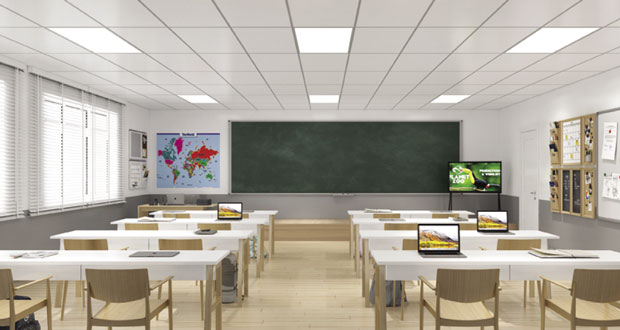Lighting systems need to remain efficient, even in sporadically used buildings. Anthony Parkinson of Ansell Lighting explores the role of smart lighting
Many businesses and their employees are opting for a more flexible, hybrid approach, splitting their hours between the workplace and home. As a result, working patterns are becoming much less regimented with varying starting and finishing times and the possibility of days where buildings may still remain vacant due to staff working from home.
This altered routine has the potential to have a significant impact on lighting requirements and could result in excessive energy use and wastage. As the world focusses on reducing its carbon footprint and achieving net zero it is important that such situations are avoided and that lighting is only used where and when it is needed. This is where the benefits of smart lighting technology really come into their own.
OPTIMISED LIGHTING
Smart lighting offers a solution which allows facilities managers to truly optimise lighting use, giving complete control over when lights are on or off or set to specific scenes or temperatures – all at the touch of a button.
Smart lighting is ideal for use in almost all indoor and outdoor settings, from car parks to industrial spaces, commercial buildings, hospitals and schools, it is an energy efficient, cost-effective solution that uses automation to ensure that lighting is only used where and when it is needed. As a result, it is the perfect solution for workplaces that are being used sporadically, where lighting requirements change regularly and according to the movement of its users.
AUTOMATION
For a fully connected workplace, products embedded with smart solutions such as OCTO are a must. OCTO is a platform that collects data from connected things in real time to help deliver the complete smart lighting package. This transforms the efficiency and ambience of commercial and residential spaces, with an easy-to-use wireless solution that gives complete control of the luminaries via an intuitive app and smart accessories. Utilising WiZ Connected or Casambi technology OCTO offers a comprehensive range of features that interact flawlessly with a smart device.
Luminaires can be linked together to create different scenes, groups and schedules. Operated via Wi-Fi and Bluetooth, they can be programmed to respond to voice or motion, can be operated remotely and can even be integrated with eco systems such as Alexa. They also eliminate the reliance on human intervention, reducing the risk of users accidentally leaving the lights on and wasting energy. There are many products available that can do this, from interior downlights to outdoor bi-directional wall lights and garden spikes.
LIGHTENING THE MOOD
In addition to fully connected systems, there are a large number of smart lighting products available which naturally regulate energy use by controlling the quality and quantity of light.
Daylight harvesting systems for example, allow buildings to maximise the availability of natural lighting, thereby reducing the need for electric lighting during periods of high-level daylight. For example, in a space with significant levels of natural daylight, the need for artificial lighting will be less, compared to areas deeper into the space where the natural lighting is either reduced or non-existent.
Products with corridor functionality or intuitive presence and absence detection sensors are also a brilliant solution for reducing energy consumption and ensuring that lights are only in use when needed. In spaces where lighting is required 24/7, they can also be used to increase output to 100 per cent when presence is detected ensuring energy for full illumination is only used when required.
One of the key reasons for returning to the workplace is to improve staff wellbeing and productivity. Smart lighting can complement this and help to further improve wellbeing by changing the colour aspect of light throughout the day to match natural circadian rhythms. Using natural, cool or warm light at different times of the day can help to focus employees and improve their sleep patterns – resulting in happier, healthier staff.
There is strong evidence to suggest that light can have a real impact on emotions, a lack of light is commonly known to lead to low mood whilst too much brightness can lead to ‘hot’ emotions. Smart lighting systems make it much easier to establish an ambient level brightness, helping to reduce mood swings that can affect individuals and their decision making.





